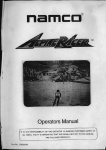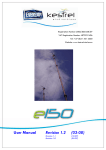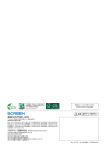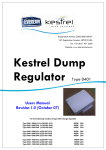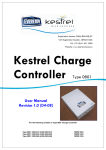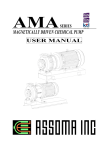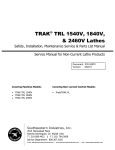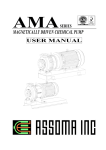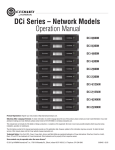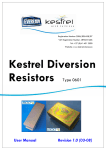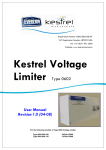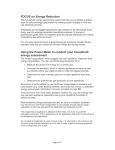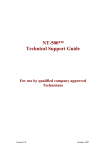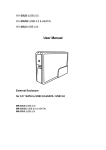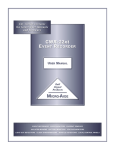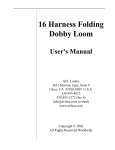Download User Manual
Transcript
e300i User Manual Approval: Document #: 0503M01A Date: March ‘08 REV : 1.3 Page 1 of 25 Registration Number 2006/005438/07 VAT Registration Number 4870231406 Tel: +27 (0)41 401 2500 Website: www.kestrelwind.co.za User Manual Revision 1.3 (03-08) Revision 1.2 Revision 1.1 Revision 1.0 (12-07) (08-07) (06-07) e300i User Manual Approval: Document #: 0503M01A Date: March ’08 REV : 1.3 Page 2 of 25 CONTENTS 1 Safety Considerations 1.1 1.2 1.3 1.4 2 Components Supplied Tools Required Unpacking Technical Requirements for Assembly Generator Assembly Pitch control Assembly Tail Assembly Fitting the Pitch Control Blade Assembly 6 6 7 8 8 8 9 10 11 Mounting Flange Detail Roof Mounting Towers 12 12 12 2 1 12 12 Turbine Wiring Lightning Protection Wire and Cable Sizes 13 13 13 3 1 14 14 Battery Considerations 6.1 6.2 6.3 6.4 7 5 Wiring and Cable Sizing 5.1 5.2 5.3 6 4 4 Site Considerations and Mountings 4.1 4.2 4.3 5 Turbine Description Identification and Markings Applications and uses Charge Controllers and Inverters Grid Tied Applications Voltage Limiter Unpacking and Turbine Assembly 3.1 3.2 3.3 3.4 3.5 3.6 3.7 3.8 3.9 4 3 3 3 3 Wind Turbine Overview 2.1 2.2 2.3 2.4 2.5 2.6 3 Mechanical Safety Electrical Safety Installation Hazards Operational Safety Lead Acid Batteries Sealed Gel Batteries NiNi-Cad Batteries Temperature Compensation 15 15 15 15 15 15 15 15 Technical Details 7.1 7.2 Technical Specification Declaration of Conformity 16 16 17 7 1 8 Trouble shooting 18 18 9 Maintenance 19 19 10 Warranty Conditions 21 11 Customer Feedback 25 25 e300i User Manual Approval: Document #: 0503M01A Date: March ’08 REV : 1.3 Page 3 of 25 Disclaimer Kestrel Wind Turbines makes every effort to give accurate information in this manual and is in no way liable for any error or omission. The user of this manual assumes full responsibility and risk. We appeal to your common sense to read and apply the safety notes. Consult professional engineers and take advice if you are unsure. 1 Safety Considerations 1 SAFETY FIRST 1.1 1.2 1.3 1.4 Mechanical Safety Electrical Safety Installation Hazards Operational Safety Although Kestrel’s wind turbines are designed with your safety in mind, accidents can easily occur and there are always inherent dangers associated with any type of machine. Consult installation professionals if you lack experience or confidence. 1.1 Mechanical Safety Use good handling methods and take precautions to avoid physical injury during installation and maintenance/repair procedures. The rotating blades of any wind turbine are a main hazard. The e300i blades are extremely tough and will cause serious injury to the body. Never install the e300i such that any person or animal could come into accidental contact with any part of the machine. Never approach the machine if the blades are rotating. 1.2 Electrical Safety The e300i output voltage can become dangerous and even lethal when running on open circuit. Maintain a healthy respect for this wind turbine. Always short the output wires together when the e300i is disconnected. Do not work on the system when the turbine is running or when lightning is possible. Disconnecting a running e300i may cause a spark and the presence of explosive hydrogen from battery charging is always a possibility. Adequate ventilation must be provided for battery installations. The wire size used for connections must be correct for the powers supplied. The smaller the wire diameter, the higher the wire losses and therefore the heat generated in the wire. Use correct wire sizes throughout the installation. The amount of energy stored in a battery is considerable and fire can result from shorts. Fit a suitable fuse or circuit breaker in the battery cable. In general, respect the system and use common sense. Consult a qualified electrician if you are unsure. 1.3 Installation Hazards All installation work should be completed at ground level wherever possible. Be very aware of the blades during installation. Contact with the blades will only injure you, not the blades. The installations of poles or towers pose their own dangers. Always work carefully and have an assistant wherever possible. Short the generator output wires (Red and Black) throughout any installation procedure. Consult a civil engineer or reputable builder if you are not sure about installing structures. Always re-check the work as you progress. Slack bolts, poor workmanship and loose electrical connections must be avoided. 1.4 Operational Safety The turbine blades are dangerous. Respect a rotating turbine. Always shut the turbine down before approaching. This may be achieved by shorting the generator output. Preventative maintenance is always the best. Checks are best carried out in calm weather conditions. Avoid any maintenance or inspection during windy weather. 3 e300i User Manual Approval: REV : 1.3 Document #: 0503M01A Date: March ’08 Page 4 of 25 2 W in d T u r b in e O v e r v ie w 2 WIND TURBINE OVERVIEW 2.1 Turbine Description 2.1 2.2 2.3 2.4 2.5 2.6 Turbine Description Identification and Markings Application and Uses Charge Controllers and Inverters Grid Tied Inverter Applications Voltage Limiter The e300i is a unique wind turbine that incorporates superior technology. The heart of the machine comprises of a unique twin axial flux permanent magnet brushless alternator. The alternator contains no less than 96 poles and 52 magnets. The polyphase high frequency output is internally rectified to give a dc output with extremely low ripple content. The generated power is transferred to the output cables via heavy duty bronze slip rings and twin copper composite electrical brushes. The prime mover on the e300i is a 3.0m (9.85’) diameter three blade wind rotor fitted with quiet running high efficiency blades. The blade hub incorporates passive pitch control. The e300i pitch control changes the operating angle of the blades to achieve speed control in high wind. The tail vane assembly is static and simply aligns the machine with the prevailing wind. All steel components are electro-galvanised and passivated for extra protection. The standard finish consists of the application of an etching marine primer and an intermediate protective coat followed by polyurethane two pack finishing coats. 2.2 Identification and Markings The turbine generator body carries a stamped unique serial number and a rating plate. Both the stamped serial number and rating plate are visible on the bottom yaw shaft housing. If this e300i does not carry this stamp it does not carry a Kestrel warranty and may not be authentic. 4 e300i User Manual Approval: Document #: 0503M01A Date: March ’08 REV : 1.3 Page 5 of 25 2.3 Applications and Uses The e300i is suitable for electrical power generation on various installations that include battery charging, water delivery and grid tie applications. Each application requires specific additional electrical equipment. Consult the manuals supplied with this equipment. 2.4 Controllers 2.4 Charge Contr ollers and Inverters Any wind turbine produces uncontrolled power that varies with incident wind speed. The open circuit generator voltage is directly proportional to generator speed (rpm). Some form of regulator must control this “raw power”. A battery charging regulator is often referred to as a charge controller. A charge controller is required for the Kestrel to charge a battery. Kestrel can supply a standard charge controller for the e300i. A suitable diversion resistor is available from Kestrel. An inverter can be connected to the battery and is used to convert the battery dc power to ac power. An inverter therefore allows the use of standard electrical equipment that works on ac voltage. 2.5 2.5 Grid Tied Inverter Applications The 200Vdc version of the e300i is suitable for connection to an approved Grid Tie Inverter. Grid Tied installation is subject to local electrical codes of practice and is usually carried out by qualified personnel. Prior approval from the local utility company must be obtained before connection to the mains. 2.6 2.6 Voltage Limiter Grid tied applications require a Voltage Limiter to be connected between the e300i (200Vdc version) and the Grid Tie Inverter. Certain operating modes of the inverter allow the Kestrel output voltage to rise beyond the limit of the inverter. The Kestrel Voltage Limiter will restrict the rise in voltage as the inverter performs various functions. Refer to the manual provided with the Kestrel Voltage Limiter. 5 e300i User Manual Approval: REV : 1.3 Document #: 0503M01A Date: March ’08 Page 3 Unpacking an d Tur6bof ine25 Assembly 3 UNPACKING AND TURBINE ASSEMBLY 3.1 3.2 3.3 3.4 3.5 3.6 3.7 3.8 Components Supplied Tools Required Unpacking Technical Requirements for Assembly Generator Assembly Tail Assembly Fitting the Pitch Control Blade Assembly Components 3.1 Com ponents Supplied The following components are supplied. Pitch hub assembly Shaft drive key Propeller blade set Generator assembly Tail boom (two pieces) Tail (two pieces) Tail Stabiliser (two pieces) Nacelle cover Nosecone All fasteners and bolts Assembly grease Locktite 3.2 3.2 Tools Required The following hand tools are required for turbine assembly and installation. 10mm metric ring spanner or socket wrench (two required) 13mm metric ring spanner or socket wrench 19mm metric ring spanner or socket wrench (two required) Small size electrical screwdriver Medium size electrical screwdriver 10mm Allen key wrench Wire strippers for electrical connections Tape measure to adjust the blades Torque wrench 6 e300i User Manual Approval: REV : 1.3 Document #: 0503M01A Date: March ’08 Page 7 of 25 3.3 Unpacking Open the packaging container and check for any transit damage. The parts contained are listed in section 3.1 and on the included packing slip. Lay out the parts and identify them with the Part Qty Description assembly drawing provided. 3. Item # 001 1 Nose Cone 30924 002 3 Screw C/Head M6x16 S/Steel 30152 003 16 Washer Plain Metric 6mm SlSteel 30092 004 1 H/Tensile Cap Screw M10x40L ZP 30660 005 1 Hub Clamping Spacer 30689 006 1 Pith Control 30990 007 1 Shaft Key (8mmx7mm) 30054 008 1 Hub to Bearing Collar 30899 009 6 Hex Bolt M12x65L S/Steel 010 3 Compression Plate 30768 011 3 e300i Blade Set 30029 012 6 Nut-Hex M12x1.75 Nylock 30173 013 1 e300i Generator Assembly 30022 014 7 Washer Plain Metric 8mm S/Steel 30096 015 7 Nut Hex M8 Nylock S/Steel 30095 016 4 Bolt Hex M8x30L S/Steel 30088 017 4 Screw M5x16 C/Head S/Steel 30149 018 1 Nacelle Cover Plate 30925 019 1 Tail Boom 30769 020 1 Nacelle 30925 021 13 Hex Nut Nylock M6x1 S/Steel 30091 022 1 Top Tail Plate 30830 023 5 Hex Bolt M6x1x80L S/Steel 30957 024 2 Clamping strip 30835 025 2 Rear Stiffner 30831 026 2 Hex Bolt M6x1x70L S/Steel 30819 027 2 Rubber Strip 30836 028 1 Bottom Tail Plate 30153 029 2 Front Stiffner 30834 030 4 Hex Bolt M6x1x16L S/Steel 30094 031 1 Spring Washer 10mm S/Steel 30053 e300i User Manual Approval: REV : 1.3 Document #: 0503M01A Date: March ’08 Page 8 of 25 4 Technical Requirements for Assem Assembly bly Torque Settings DESCRIPTION NOSE CONE SCREWS FRONT BOLT BLADE BOLT TAIL BOOM NACELLE SCREWS TAIL BOLTS MOUNTING BOLTS BOLT TYPE TORQUE (Metric) TORQUE (Imperial) M6 x 16, S/S 12.9 HI-TENSIL + LOCTITE M10 X 35 M12 x 80, S/S WITH M12 NYLOCK NUT M8 BOLTS, S/S M8 NYLOCKS M6 x 16, S/S M5 x 15, S/S M6 x 60, S/S WITH M6 NYLOCK NUT M8 x 25, 8.8 HI-TENSIL PLATED 5Nm 60Nm 35Nm 30Nm 25Nm 3Nm 3Nm 10Nm 35Nm 3,7 ft·lb 44,3 ft·lb 25,8 ft·lb 22,1 ft·lb 18,4 ft·lb 2,2 ft·lb 2,2 ft·lb 7,4 ft·lb 25,8 ft·lb Generator 3.5 G enerator Assembly The alternator (01) is factory assembled. 3.6 Pitch control Assembly The pitch control boss (03) is factory assembled. 8 e300i User Manual Approval: Document #: 0503M01A Date: March ’08 REV : 1.3 Page 9 of 25 3.7 3.7 Tail Assembly (if not factory assembled) Offer the tail boom (05) to the rear of the generator and align the three inner fixing holes with the inner studs. Fasten the boom to the rear of the generator with the three M8 Nylock nuts (18). Now fit the four lower bolts (20), washers (19) and nuts (18) on to the generator sides by means of the side bars. Level the boom with the generator, secure the bolts through the rubber bushes so that the boom is held in place and tighten all fastenings to the required torque setting (see 3.4 Pg 7). Slide the nacelle cover (0730) along the boom so that it is covering the generator. Secure the nacelle cover to the rear of the generator with the two M6 screws to the required torque setting (see 3.4 Pg 7). Slide the front closing plate between the underside of the generator and the nacelle cover and secure with the four M5 screws to the required torque setting (see 3.4 Pg 7) through the holes provided. Fasten the tail (07) upper and lower halves to the boom with the ten stainless bolts (23), stainless flat washers (24) and with the ten stainless Nylock nuts (23) provided. Now fit the tail stabilisers, two on each side of the tail using the one longer stabiliser bolts (27) through the tail boom and the middle of each stabiliser on either side. The other two stabiliser bolts (26) are fitted through the tail with the washers (28) and nuts (29) at each end of each stabiliser. Do not over-tighten such that the tail boom is crushed or distorted. Always adhere to the torque settings provided. Check once again that all bolts are fitted and tightened to torque settings (3.4). 9 e300i User Manual Approval: Document #: 0503M01A Date: March ’08 REV : 1.3 Page 10 of 25 3.8 3.8 Fitting the Pitch Control The generator is a complete unit. The shaft drive key is factory fitted to the generator shaft with a cable-tie. Remove cable-tie, before fitting pitch control. Smear waterproof grease (30) over the shaft and insert a little inside the front of the generator where the shaft projects out. Offer the pitch control hub to the shaft and slide it onto the shaft. Using a hexagon key, fit the front shaft bolt (15) and washer (14) to the spring locking washer provided into the generator shaft and tighten the assembly. It is important that the bolt is secured with Locktite. 10 e300i User Manual Approval: Document #: 0503M01A Date: March ’08 REV : 1.3 Page 11 of 25 3.9 3.9 Blade Assembly e300 i IMPORTANT: The wheels of a car are balanced to allow smooth operation. In the same way, the propeller rotor must be assembled such that it is balanced. Rotor imbalance will cause vibration, unstable operation of the turbine and eventual damage. Please follow the steps given below to assemble a balanced rotor. GENERAL NOTE: The blades are fitted on the front of the pitch control hub. Refer to the assembly drawing and fit all three blades on to the hub as shown. Each blade carries a serial number and a balance mark on the front face of the blade. Be sure to fit the blades the correct way round. The blade root is marked “FRONT” below the serial number on each. The rotation is clockwise viewed at the front of the turbine. Each blade mount has two bolt holes. Fit the bolts with the washers provided and through the blade compression plate with the Nylock nuts behind the pitch control. The blades are factory balanced. Note that exact balancing requires that the three blade tips be equally spaced when fitted. Please follow the instructions given below. a) Support the generator (02) such that the blades can be fitted to the pitch hub (03). b) Fit two blade bolts (11) through a blade compression plate (09) such that they face toward the generator. Now fit the first blade (08) on to the bolts and offer the blade from the front to one blade mount. Fit the two Nylock nuts (13) on to the blade bolts from the rear. Do not tighten the nuts. c) Repeat (b) such that all three blades are sandwiched between the three compression plates (09) and the three blade mounts on the pitch control hub. Now gently tighten all six blade bolts such that each blade can still move sideways. d) Using a tape measure, accurately measure the distance between each of the three blade tips. Move each blade sideways until all three blade tips have the same measured distance between them. e) Now tighten all the blade bolts to the required torque setting (see 3.4 Pg 7). Do not over-tighten the bolts such that any blade is damaged or crushed. f) Check the assembly for correctness. Check the blades are fitted correctly, the bolts are all tightened and that the rotor spins freely and evenly on the generator. Check the distance between the three blade tips (or balance marks) to be equal. g) Now fit the nose cone (10) over the three spokes and fit the three Nylock nuts (16) and washers (17). 11 e300i User Manual Approval: Document #: 0503M01A Date: March ’08 REV : 1.3 Page 12 of 25 4 Site Considerations and Mounting 4 SITE CONSIDERATIONS AND MOUNTING 4.1 Flange Mounting Detail 4.2 Roof Mounting 4.3 Towers The turbine is supplied with a “weld on” mounting flange for adaptation. Custom structures must incorporate a 76mm (3”) - 100mm (4”) diameter pipe for machine mounting. Larger pipes may interfere with the blades when pitch control operates. There are infinite variations on sites and the information and suggestions may be adapted to suit local conditions. Wind speed increases with height above the ground. An installation site should be chosen which is free of obstructions like buildings, trees, mounds and hills. A "pure" airflow is paramount for good performance. Naturally some compromise can be reached but there should be a clear entry for the prevailing wind direction of the location. The absolute minimum height of the structure should be 9m when placed clear of obstructions. The general rule is that the e300i should be 8m (25’) higher than any obstruction within a 150m (500’) radius of the tower. Otherwise mount the e300i as high as possible. All obstructions add to possible turbulence, which will cause undue stress on the unit and reduced performance. Wind speed increases with height above the ground. The power in the wind is a cubic function of wind speed. Doubling the wind speed increases the power by eight times. 4.1 Flange Mounting Detail The e300i is mounted using eight M8 Hi-Tensile bolts and spring washers fitted through the bottom flange on the weather cocking swivel assembly. 4.2 Roof Mounting Roof mounting is possible but the turbine performance may suffer as a result of wind shift and turbulence. Roof mounting structures are beyond the scope of this document and must comply with the relevant structural standards that are in force. 4.3 4.3 Towers Towers are required to conform to relevant standards and must be designed to withstand the loading regime of the wind turbine. Full details are included with any Kestrel tower kit supplied. 12 e300i User Manual Approval: Document #: 0503M01A Date: March ’08 5 WIRE AND CABLE SIZES 5.1 Turbine Wiring REV : 1.3 Page 13 of 25 5 Wiring and Cable Sizes 5.1 5.2 5.3 Turbine Wiring Lightning Protection Wire and Cable Sizes The e300i wind turbine produces dc power and therefore has two double insulated output wires (tails). The RED wire is POSITIVE and the BLACK wire is NEGATIVE. Observe the Polarity at all times. Only connect +VE RED cables to +VE RED terminals and -VE BLACK cables to -VE BLACK terminals. Otherwise, equipment damage may result and any warranty will be invalidated. The following suggestions are made as a guideline. If you are in doubt, consult an electrician. The output wires must be extended as required for the installation. Good wire connections are absolutely essential to avoid poor power delivery and high temperatures at the connection. All electrical systems lose energy because cables have a resistance. The mounting structure must be directly earthed for lightning. The power cable is usually brought down the inside of the mounting structure to give some protection. Supply cables should never be spanned or suspended from the turbine structure and should be buried at least one half metre deep in a suitable plastic or steel conduit. 5.2 Lightning protection Proper grounding is essential to protect the system from induced voltages and static. Local requirements for electrical installations must be satisfied. Ensure that the generator is electrically connected to the mounting structure and that the structure is earthed. This is usually done by burying a 2 to 3m (6’ – 10’) length of water pipe (steel or copper) horizontally, 1000mm (3.3’) below the ground surface. A good connection is made between the middle of the pipe and the structure. An improved method is to bury a cross of pipe, which requires a "X" shape to be excavated. The connection is made in the centre of the cross. The negative battery connection should also be grounded using a ground point close to the battery. First, consult the Charge Controller Manual to avoid earth loops. The wire size for grounding should be the same size as the power cables. Commercial lightning arrestors are available at electrical stores and can be fitted at the bottom of the structure or pole or at the regulator input. 13 e300i User Manual Approval: REV : 1.3 Document #: 0503M01A Date: March ’08 Page 14 of 25 5.3 Wire and Cable Sizes The copper wire sizes given in the tables are calculated for 3% power loss in wire resistance. This is usually acceptable in low voltage installations. A larger wire size will increase the delivered power but usually a compromise is reached as larger cables cost more. It is recommended that the wire sizes given be taken as a minimum value. Measure the distance from the top of your structure (i.e. the e300i ) to the regulator. Select the wire size for that distance from the table. The double run of +ve and -ve is already accounted for. The power cable should be run down the inside of the pole or structure and then buried in a suitable underground conduit at least 500mm below the ground surface. Wire Size for 12V e300i (65A maximum current) 10m (33’) 20m (66’) 50sq mm (0) 85sq mm (000) Wire Size for 24V e300i (35A maximum current) 10m (33’) 20m (66’) 30m (96’) 40m (130’) 50m (165’) 16sq mm (5) 35sq mm (2) 40sq mm (1) 70 sq mm (00) 85 sq mm(000) Wire Size for 48V e300i (19A maximum current) 10m (33’) 20m (66’) 30m (96’) 40m (130’) 50m (165’) 80m(260’) 100m (330’) 6sq mm (9) 10sq mm (7) 16sq mm (5) 20sq mm (4) 25sq mm (3) 40sq mm (1) 50sq mm (0) Wire Size for 110V e300i (12A maximum current) 10m (33’) 20m (66’) 30m (96’) 10sq mm (7) 20sq mm (4) 35sq mm (2) 40m (130’) 35sq mm (1) 50m (165’) 50sq mm (0) 80m(260’) 70sq mm (00) 100m (330’) 100sqmm(0000) Wire Size for 200V e300i (6A maximum current) 20m (66’) 40m (130’) 60m (200’) 80m(260’) 100m (330’) 0,5sq mm (20) 1,5sq mm (15) 2,5sq mm (14) 2,5sq mm (14) 4sq mm(11) 14 e300i User Manual Approval: REV : 1.3 Document #: 0503M01A Date: March ’08 Page 15 of 25 6 Battery Considerations 6 BATTERY CONSIDERATIONS 6.1 6.2 6.3 6.4 Lead Acid Batteries Sealed Gel Batteries Ni-Cad Batteries Temperature Compensation Batteries are available in many shapes, sizes and chemistry. Battery dealers will be pleased to assist. The most common ones are reviewed below. In general, only "Deep cycle" batteries and cells should be used and automotive or vehicle batteries will have a short life as they are not designed for cyclic charging and discharging. A cell is a single unit of 2V and a battery consists of a number of cells joined in series. The usual installation consists of 12V batteries arranged in series or parallel, or both. Batteries should not be exposed to temperature extremes and good ventilation is required as batteries can emit hydrogen while being charged. The stored energy in a battery is given in Ampere Hours (Ah) or Watt hours (Wh). The capacity is often based on a 10 hour discharge rate. A 100Ah battery will therefore supply a current of 5A for 20hrs or 10A for 10hrs or 20A of current for 5hrs. It will not however supply 100A of current for 1hr. There is much literature available on this subject. It is recommended that the e300i should be charging at least 200Ah of battery capacity for a 12V system. 6.1 Lead Acid Batteries. These are the most popular choice of battery type and can be vented/flooded (Water may be added), or semi-sealed or low maintenance (Water cannot be added). Charging voltage is typically 13.8-14.0 / 27.6-28.0Vdc for these batteries. 6.2 Sealed Gel Batteries Sealed gel batteries are more expensive but offer clean and safer operation as no acid can be spilled. Since they are sealed, they must never be boosted and the charging voltage is important. Charging voltage is typically 14.0 / 28.0Vdc. Consult your battery supplier. 6.3 Ni Ni--Cad Batteries This type of battery is traditionally used where large currents must be delivered and where deep cycling is required. They are however relatively expensive. Consult your battery supplier for details. 6.4 Temperature Compensation Much has been documented on this subject and there are certain merits. Generally, lower and higher ambient temperatures allow higher and lower charging voltages respectively. K1000 regulators do not have this facility. Batteries should be sited in a cool area and temperature compensation is only useful in extreme temperature variations. 15 e300i User Manual Approval: Document #: 0503M01A Date: March ’08 REV : 1.3 Page 16 of 25 7 Technical Details 7 TECHNICAL SPECIFICATIONS 7.1 Technical Specifications 7.2 Declaration of Conformity 7.1 TECHNICAL SPECIFICATIONS e300i Maximum Power 1150W Rated power at 11m/s 200Vdc 1000W Rated power at 11m/s 48Vdc 1000W Rated power at 11m/s 24Vdc 900W Rated power at 11m/s 12Vdc 850W Annual energy capture at 5m/s average 200Vdc 2160kWh Annual energy capture at 5m/s average 48Vdc 2060kWh Annual energy capture at 5m/s average 24Vdc 1940kWh Annual energy capture at 5m/s average 12Vdc 1790kWh (For average wind speed of 5ms-1 and 12m tower at sea level) Rated sound level <50dB Cut-in wind speed 2,5ms-1 Cut-out wind speed N/A Maximum voltage 200Vdc 1000Vdc Maximum voltage 48Vdc 250Vdc Maximum voltage 24Vdc 150Vdc Maximum voltage 12Vdc 70Vdc Output power form Two wire DC Rotor swept area 7,07 sq m No. of blades 3 Tower top mass 75kg Lateral Thrust at 12ms-1 (27mph) and 40ms-1 (90mph)* 800N and 8600N *NOTE: Lateral Thrust at 40ms-1 is theoretical for a failed pitch control. For normal operation, thrust at 40ms-1 is <1000N Speed Control Passive pitch Protection IP55 16 e300i User Manual Approval: Document #: 0503M01A Date: March ’08 REV : 1.3 Page 17 of 25 7.2 DECLARATION OF CONFORMITY CONFORMITY 17 e300i User Manual Approval: Document #: 0503M01A Date: March ’08 REV : 1.3 Page 18 of 25 8 TROUBLE SHOOTING REST ASSURED THAT THE KESTREL WILL BE SERIOUSLY DAMAGED FROM POLARITY REVERSAL. OVERCHARGING OF THE BATTERY CAN OCCUR WITH NO FITTED CHARGE CONTROLLER. IT IS UNWISE TO DISCONTINUE CHARGING BY DISCONNECTING THE e300i FROM THE BATTERY. THE TURBINE THEN HAS NO LOAD WHATSOEVER AND CAN REACH VERY HIGH ROTATIONAL SPEEDS. Uncontrolled output voltage can reach LETHAL values. IF THE e300i IS DISCONNECTED FOR ANY REASON, SHORT THE GENERATOR OUTPUT WIRES. THIS WILL LOAD THE GENERATOR AND MINIMISE ROTATION. DO NOT ALLOW THE e300i TO OPERATE WITH DAMAGED BLADES OR TAIL. DAMAGE TO THE BLADES WILL CAUSE VIBRATION THAT CAN INCREASE TO DESTRUCTIVE LEVELS. DO NOT ALLOW THE e300i TO OPERATE WITH ANY SIGN OF UNBALANCE. ANY REPETITIVE SWINGING OF THE TAIL INDICATES THAT THE MACHINE IS UNBALANCED. Q A There is wind but the e300i does not rotate or only rotates very slowly. The e300i output is shorted. There is an electrical short elsewhere in the system. The blades are fitted the wrong way round. The e300i is restricted from swinging 360 degrees into the wind. The charge controller is defective. Other connected equipment is defective. (Disconnect the e300i from the equipment and check that the blades rotate easily). There is a short within the turbine generator. In very light wind, the e300i may well not rotate. This is quite normal as there is no useful power in such a light wind and bearing life is greatly extended. On older machines, check the generator bearings. Q The e300i is rocking from one side to the other at low speed but appears to run smoothly at higher speeds. The blade rotor assembly is unbalanced. Remove the rotor and check for damaged blades. Rebalance the rotor if possible or fit a new blade set. A Q A The e300i is vibrating or noisy. Check all fasteners on the unit, in particular the blade assembly. Vibration or noise can only be caused by the imbalance of damaged blades. Check for bearing wear on older machines. Q A Can the e300i be left running and disconnected? Theoretically yes, but high voltages may be produced. Always short the output wires when the e300i is disconnected from the regulator. Q A What should be done in storm conditions? Never approach the e300i during strong wind conditions. The e300i has been tested up to winds of 160km/h and is designed to survive such conditions. It is acceptable to lower the turbine for predicted extreme weather conditions simply for peace of mind. 18 e300i User Manual Approval: Document #: 0503M01A Date: March ’08 REV : 1.3 Page 19 of 25 9 MAINTENANCE The e300i is designed for continuous operation on 100% duty cycle and requires no regular part replacement. NEVER APPROACH A ROTATING TURBINE The e300i is designed to operate with minimum maintenance. The frequency of visual inspections and integrity checks depends on the wind class of the installation site. Wind Power Class definition for wind power density and average wind speed at a hub height of 10m is given below. In general, higher class wind sites require more frequent installation checks. WARNING (Pitch Control) The pitch control mechanism is a factory assembly and is not user serviceable. Specialist tools and knowledge is required to carry out any maintenance or repair procedures. Do not make any unauthorized adjustments or modifications to any part of this assembly. Do not force or twist the blades other than gently when checking for wear. Wind Power Class 1 2 3 4 5 6 7 Wind Power Density (W/sq m) Up to 100 100 – 150 150 – 200 200 – 250 250 – 300 300 – 400 Above 400 Wind Speed m/s Up to 4,4 4,4 – 5,1 5,1 – 5,6 5,6 – 6,0 6,0 – 6,4 6,4 – 7,0 Above 7,0 Wind Speed mph (Imperial) Up to 9,8 9,8 – 11,4 11,4 – 12,5 12,5 – 13,4 13,4 – 14,3 14,3 – 15,7 Above 15,7 NOTE: PRODUCT SPECIFICATIONS MAY CHANGE DUE TO CONTINUOUS DEVELOPMENT. CONSULT THE FACTORY OR AN APPOINTED DEALER. 19 e300i User Manual Approval: REV : 1.3 Document #: 0503M01A Date: March ’08 Page 20 of 25 The following schedule is designed to avoid machine failure. Component life will be reduced on sites that exhibit high turbulence. Wind Power Class First post installation visual check Visual Inspection, listen for abnormal noise and vibrations. Close inspection, check for any loose bolts, blade damage. Check the integrity of the pitch control (see tips below). Touch up paint. Dismount the machine and check for transfer brush wear. Check for wear on pitch control parts. Replace as required. Treat any corrosion and touch up paint. Dismount the machine and replace all bearings (generator, yaw shaft and pitch control) 1 2 3 4 5 6 7 All sites 1 month after installation After extreme weather and every 3 months 12 monthly intervals After extreme weather and every 2 months Six monthly intervals Every 5 years Every 3 years Every 8 – 10 years Every 4 – 5 years Other Auxiliary Inspections a) b) c) d) Inspections should also be done with regard to all other site equipment. Specific procedures are contained within the relevant user manuals. The following list illustrates typical topics. Inspection of the tower including all bolts/fasteners ground anchors and guy wires. Inspection of the e300i tower securing bolts. Check all electrical connections for tightness and corrosion. Functionality and general checks on all other electrical equipment. Maintenance Tips The pitch control hub should be checked in the following way. Visually inspect the unit. Check for any stress cracks, broken or cracked springs and/or corrosion. Use gentle pressure to twist the blade in both directions. There should be virtually no movement or slackness. Push and pull the blade along its length. There should be no movement of the blade. If any wear or defect is detected, consult your dealer or the Kestrel factory. Do not under any circumstances strip the assembly down without the required knowledge. The generator produces a slight humming sound. This is quite normal. Any other grinding, clicking or scraping noises are abnormal and must be investigated. Good rotor balance is very important for long and reliable operation. The wind turbine must not be allowed to continue in operation if any unbalance is observed. The most common symptom of imbalance is observed when the turbine swings slightly from side to side as it speeds up. The swinging action will be worse at a particular rotor speed and may well disappear at higher speeds. The rotor blades can suffer chips and erosion, mainly on their leading edge. Small chips can be repaired with glass fibre filling compound. All cracks must be carefully examined. Surface cracks can be repaired but any structural cracks must render the blade inoperative. If there is any doubt, the blade set must be replaced for safety. All blade damage can allow water to enter. This will cause the blade set to become unbalanced which will cause other mechanical failures and shortened bearing life. 20 e300i User Manual Approval: Document #: 0503M01A Date: March ’08 REV : 1.3 Page 21 of 25 10 WARRANTY CONDITIONS WARRANTY AGREEMENT Kestrel’s wind turbines are manufactured to the highest standards, in accordance with Kestrel Wind Turbines’ standard and quality specifications, and warrants that the wind turbine is in good working order upon delivery and for a period of 24 months. Warranty terms and conditions are outlined below. 1. Eveready warrants that Turbines will, on delivery, be free of defects in design, material and workmanship and will be fit for their intended purpose for a period of two years calculated from the date of installation, subject to proper installation, maintenance and use in accordance with the User Manual. 2. This warranty is further subject to the Customer returning the defective Turbine at its cost to the premises of Eveready within the warranty period and furnishing full details in writing of the alleged defect. 3. Eveready's obligations under this warranty shall be limited to the repair or replacement of defective Turbines at its cost or to a refund to the Customer of the original cost thereof, as Eveready may determine in its discretion. Eveready shall not be responsible for any damages suffered by the Customer pursuant to any defects covered by this warranty. 4. This warranty shall not apply to any damage to Turbines caused by winds exceeding 160 kilometres per hour or any other factors beyond the control of Eveready. 5. The Customer may purchase an extended warranty from Eveready in respect of Turbines, subject to Eveready's standard conditions. 21 e300i User Manual Approval: Document #: 0503M01A Date: March ’08 REV : 1.3 Page 22 of 25 CONTACT KESTREL WIND TURBINES Kestrel Wind Turbines P.O. Box 3191 Eveready Diversified Products (Pty) Ltd North End Eveready Road Port Elizabeth Struandale 6056 North End Eastern Cape Port Elizabeth Republic of South Africa South Africa Tel: +27 (0)41 401 2500 Email: [email protected] Registration Number 2006/005438/07 VAT Registration Number 4870231406 Web: www.kestrelwind.co.za 22 e300i User Manual Approval: Document #: 0503M01A Date: March ’08 REV : 1.3 Page 23 of 25 NOTES 23 e300i User Manual Approval: Document #: 0503M01A Date: March ’08 REV : 1.3 Page 24 of 25 NOTES (continued) 24 e300i User Manual Approval: Document #: 0503M01A Date: March ’08 REV : 1.3 Page 25 of 25 11 CUSTOMER FEEDBACK Customer enquiry and feedback sheet Customer Information Customer Name: Postal Address: Turbine Number: Phone Number: E-Mail Address: Fax Number: Enquiry Details Complete the form and submit to Kestrel Wind Turbines. Your feedback and queries are valuable to us. Indicate your enquiry or feedback in the space provided below For OFFICIAL Use Only Date Replied: Signature: Comments: 25

























